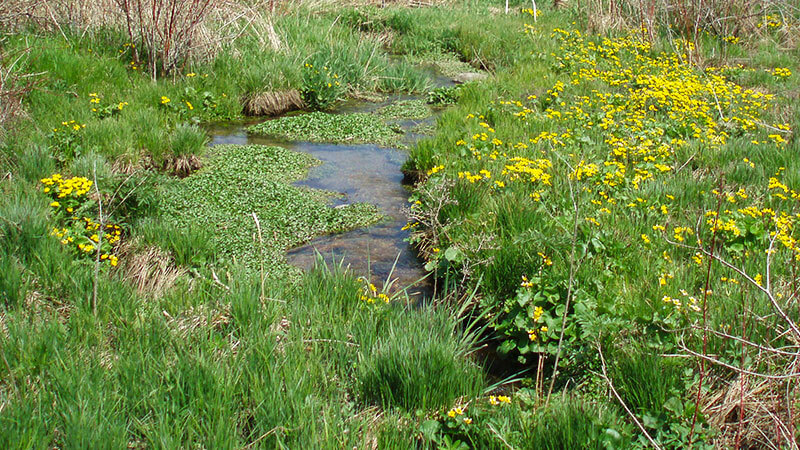MMSD's natural flood controls, green infrastructure aid region
I'm sure it hasn't hurt the Milwaukee Metropolitan Sewerage District's multi-county 1,000,000+ residents during the recent heavy rains that its wetlands-and-shoreline natural flood control program known as Greenseams now totals more than 3,400 water-absorbing acres and 100,000 trees planted.
Water flows from a natural spring on Greenseams® Hoerig propertyAnd while the Wisconsin Department of Natural Resources is busy scrubbing climate change science from its official website, and other state government agencies drag their feet while Wisconsin gets wetter and warmer, the MMSD acknowledges the realities of climate change and its obligations to adapt, expand Greenseams and boost other elements of green infrastructure to serve the people and save us money, as the agency notes in its current plan goals:
The Milwaukee Metropolitan Sewerage District’s 2035 Vision and Strategic Objectives
Integrated Watershed Management Goals:
a. Support a watershed-based permitting program and water quality trading program that improves environmental performance in a cost effective manner.
b. Work with MMSD’s partners to strive toward zero basement backups.
c. Work with MMSD’s partners to achieve, to the extent feasible, zero sanitary sewer overflows and zero combined sewer overflows.
d. Work with MMSD’s partners to achieve zero homes in the 1% probability floodplain.
e. Acquire an additional 10,000 acres of river buffers through GreenseamsSM and other regional programs.
f. Use green infrastructure to capture the first 0.5 inch of rainfall.
g. Harvest the first 0.25 gallons per square foot of area of rainfall.
Integrated Watershed Management Initiatives:
a. MMSD will help municipalities within the District reduce the volume of flows they deliver to MMSD’s sewer system cost effectively.
b. Continue to plan, design, construct, and operate MMSD’s grey infrastructure to exceed regulatory and economic requirements.
c. GreenseamsSM
1) Expand the boundaries of the GreenseamsSM program to match regional watershed boundaries.
2) Designate a percentage of annual GreenseamsSM funding toward improving the rainwater storage capacity of the properties.
d. Maximize MMSD’s ability to deliver public educational programming to increase the general public’s support and understanding of its operations.
e. Integrate green infrastructure with MMSD’s grey infrastructure.
Climate Mitigation & Adaptation Initiatives:
a. Create and support a robust southeast Wisconsin regional climate change modeling program that will help forecast climate change impacts.
b. Create an internal risk analysis process that characterizes near-, mid- and long-term actions necessary to protect MMSD’s existing investments in facilities and create new facilities, programs, and operational improvements that adapt to the wet weather impacts of climate change.
c. Expand green infrastructure to help to mitigate climate change and make the region more resilient in the face of intense storms.
Realizing a cleaner, healthier environment is within the District’s grasp. Aggressive collaboration will be the key to success, and ensuring that the District utilizes a sustainable bottom line approach in taking the steps outlined in this Vision will make sure a balance is met as MMSD proceeds.
Separately - - Glad to see the UWM School of Freshwater Science is continuing through course offerings its contribution to a clean environment through stormwater mitigation.
Separately - - Glad to see the UWM School of Freshwater Science is continuing through course offerings its contribution to a clean environment through stormwater mitigation.
Registration Deadline: Fri., Oct. 27
Using Native and Naturalized Landscape for Designing Effective Site Stormwater Systems
Gain an understanding of how to analyze, design, implement and manage effective and innovative stormwater management systems using native landscape for a variety of sites – large, small, rural, urban. Learn about how a thorough site analysis of soils, terrain and hydrology can influence design approach using native and naturalized plant selections. Several case studies of built projects are presented and the attendees get first-hand knowledge of how to approach site design, plant selection, construction and maintenance.










No comments:
Post a Comment